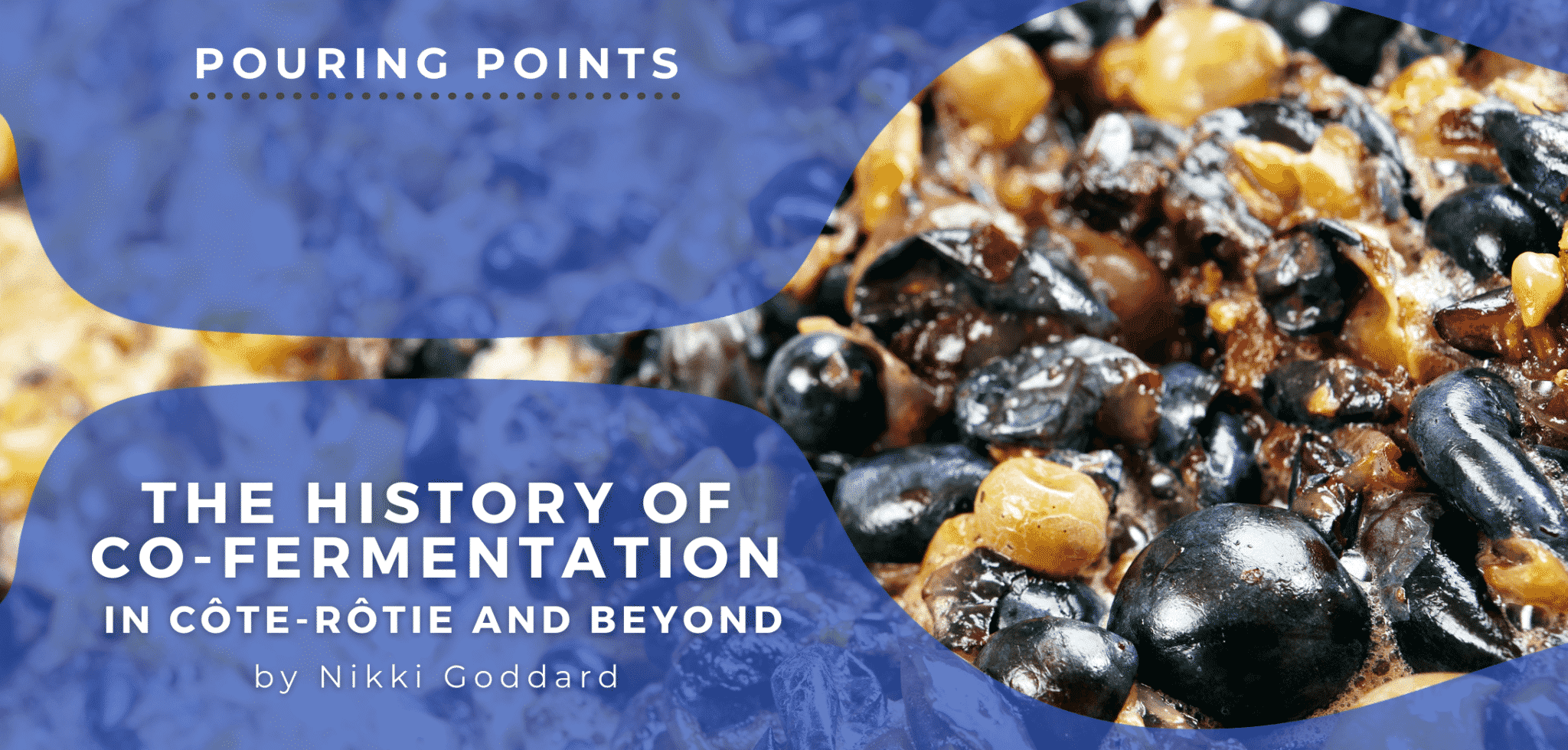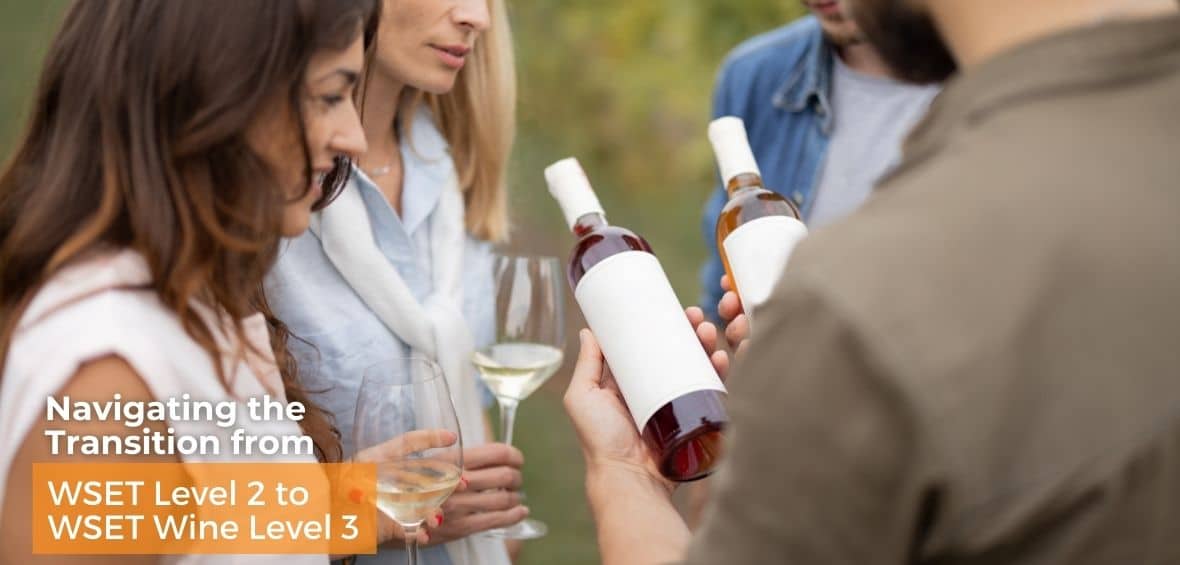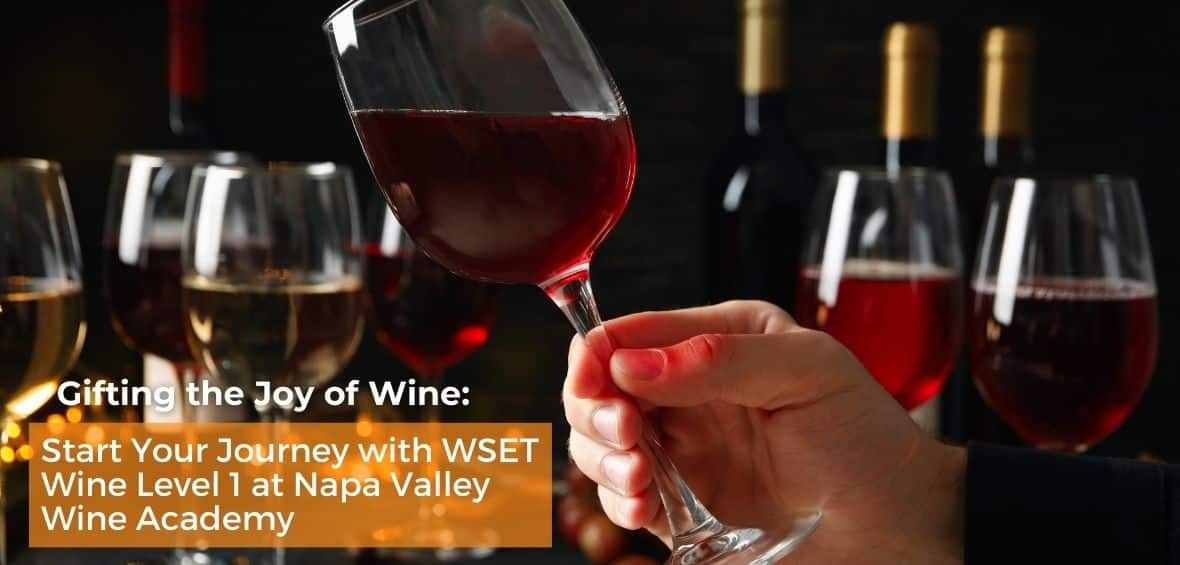The History of Co-Fermentation in Côte-Rôtie and Beyond
By Nikki Goddard
In nearly every quality wine region on the planet, it’s safe to assume that a bottle of red wine contains exclusively red grapes. But in a small handful of appellations, it’s common—even expected—to find a deeply colored, richly concentrated red wine that has been enhanced by the inclusion of white grapes prior to fermentation. Advocates of this technique maintain that with co-fermentation, the whole is greater than the sum of its parts and that the color, aromas, and textures can benefit significantly from its use.
The traditional practice of co-fermentation dates back to the early days of viticulture when vineyards were planted with mixed varieties, often indistinguishable from one another in the days before modern ampelography and DNA fingerprinting. The entire vineyard would be harvested and fermented simultaneously, producing a so-called “field blend.” Co-fermentation, a more intentional practice, developed in regions like Rioja and Tuscany, where a small percentage of white grapes was used to soften the tannins of red varieties (e.g. Chianti Classico was historically a co-ferment of Sangiovese with the indigenous red grape Canaiolo Nero as well Trebbiano and Malvasia). Today, the practice has largely fallen out of favor in the classical regions of Europe, with one notable exception.
In Côte-Rôtie, the northernmost appellation of the Northern Rhône, only red wine production is permitted, and Syrah is the star of the show. But Viognier, a white variety, frequently takes on a supporting role—up to 20 percent, per regional regulations, though rarely more than five to 10 percent in practice. The rules state that if Viognier is used, it must be co-fermented, rather than blended after fermentation is complete. This can be done by combining whole fruit prior to or after crushing, or by adding the juice of white grapes to crushed Syrah must. Co-fermentation is permitted in two other Northern Rhône appellations, Saint-Joseph and Hermitage, but is rarely practiced; a likely explanation is that the white varieties planted there, Marsanne and Roussanne, don’t share the unique aromatic characteristics that make Viognier particularly appealing for enhancing the qualities of Syrah.
Côte-Rôtie, a sun-baked yet wind-swept appellation with a marginal continental climate, is just north of Condrieu, the spiritual home of Viognier and the most prized terroir for the variety worldwide (alongside Château Grillet, a monopole completely enclosed within Condrieu). Both Syrah and Viognier have long been grown around the Côte-Rôtie commune of Ampuis, and are in fact believed to be relatives of one another—Viognier is likely either a half-sibling or grandparent of Syrah. It is probable, but unconfirmed, that they both originate from this part of the world. It is not known precisely when it became standard practice to co-ferment the two varieties, but prior to the official guidelines, both were planted on either side of the border between the appellations now known as Condrieu and Côte-Rôtie. When the regions received AOC status in 1940, red wines were assigned to the north, and whites to the south, of the newly demarcated border.
Viognier’s acreage, both in Côte-Rôtie and beyond, decreased significantly after the mid-19th century scourge of phylloxera—in fact, the grape very nearly became extinct. Most growers opted not to replant the variety, due to the difficulty and expense of growing it on the Northern Rhône’s steep, terraced slopes; Syrah was simply better suited for the local terroir, and significantly more profitable. By the late 1960s, there were just 14 hectares (34.5 acres) of Viognier remaining in the world. A small group of local producers, led by Georges Vernay, rallied to save Viognier from obscurity, and it has since made a significant comeback, not just in the Rhône but worldwide. Today, most Côte-Rôtie plantings of Viognier are found on the slope known as the Côte Blonde, where the loose gravel soils mirror those of Condrieu.
A heady, hedonistic white variety, Viognier is known for its high potential alcohol and viscosity, and intense aromatics. Typical descriptors include ripe peach and apricot, honeysuckle, gingerbread, orange blossom, jasmine, and sweet baking spice. Viognier wines tend to be low in acidity, with an oily, viscous texture. Winemakers who embrace the co-fermentation of Viognier with Syrah find that the voluptuous variety tends to add a sweet, floral perfume that appealingly contrasts the rustic, gamey character of Syrah—a grape known for deep, savory notes of leather, licorice, tar, white pepper, bacon fat, and campfire smoke, alongside brambly black fruit. When Syrah is co-fermented with Viognier, it is believed by many to create a much more complex, nuanced wine.
The fragrance alone is a compelling reason to co-ferment Viognier with Syrah, but it’s not the only one. Early Côte-Rôtie winemakers may have utilized Viognier as an early form of chaptalization, due to its ability to bolster alcohol levels in cool vintages when Syrah was unable to ripen sufficiently. Similarly, Viognier can help soften the body of Syrah to create a more elegant, opulently textured wine.
Co-pigmentation is yet another desirable result—when white and red varieties are co-fermented under ideal conditions, the color of the red wine is stabilized and deepened, typically shifting the hue from red to purple. This is a result of the molecular interaction between anthocyanins (the phenolic compounds that contribute color to red wine) and colorless phenolic compounds, also called “cofactors.” For co-pigmentation to be effective, the red grapes must be relatively low in colorless cofactors, while the white grapes must be relatively high in them. These levels can vary from vintage to vintage.
Under ideal conditions, Viognier’s colorless cofactors help to polymerize the anthocyanins in the Syrah, forming long molecular chains of tannins that are highly stable, so that they will not degrade through oxidation over time. Research suggests that the ideal ratio is about 10% white grapes—a smaller proportion would have less effect, and a larger proportion would dilute the pigment.
The best co-fermented Côte-Rôtie wines show a great deal of finesse in their pure red, purple, and black fruit character, a striking interplay between savory and floral notes, and silky, sensuous textures. Perhaps the best examples of the style are La Mouline and La Turque—two of the three so-called “La-Las” of legendary producer Guigal. La Mouline, the most floral of the trio, typically contains 11 percent Viognier, and La Turque contains around seven percent. Both cuvées come from the Côte Blonde, where lighter granite- and gneiss-based soils offer ideal conditions for growing Viognier as well as more delicate Syrah fruit. The third La-La, La Landonne, is 100 percent Syrah from the darker terrain of the Côte Brune, where clay- and iron oxide-dominant soils lead to more robust, powerful wines.
Critics and skeptics of co-fermentation have varied explanations for their hesitance*. One of these is the lack of control over the finished wine—winemakers typically prefer to blend after fermentation, when they have a clear sense of how the components will best work together. When wines are co-fermented, the proportions must be determined at the outset, leaving no room to adjust the blend prior to bottling. Some winemakers believe that Viognier’s abilities have been overstated, and that the grape adds nothing aromatically to the final wine, except, perhaps, a placebo effect (though they find it harder to dispute the beneficial effect on the texture of Syrah). Even if a producer does choose to co-ferment Viognier with Syrah, they may opt not to list the variety on the label. After a surge in popularity during the 1990s, the grape is viewed by some as an overexposed, overrated passing fad, and a subset of weary consumers may find themselves turned off by its presence.
Co-fermentation also presents logistical challenges: both (or all) varieties must be ripe at the time of processing. Syrah and Viognier make natural blending partners in the Northern Rhône, where Syrah often struggles to ripen sufficiently; by the time it is picked, the Viognier will have become quite ripe, making it ideal for enhancing the body and texture of the Syrah. In New-World regions like Australia and California, where ripening is less of a challenge, this can be more of a liability than an asset, although refrigeration of the earlier-harvest variety can be a modern workaround for this problem.
Regardless of personal preferences, it seems clear that the traditional practice of co-fermenting Viognier with Syrah was not originally an intentional stylistic choice, but a pragmatic one. Viognier has long been planted among the Syrah vines in Côte-Rôtie, and it would require significant effort and expense to separate the fruit during harvest, or to tear up and replant the vineyards. It’s challenging enough to discern one variety from the other—even vine nurseries have trouble distinguishing between the two. In a 2003 Decanter article, René Rostaing remarked, “I recently ordered some Syrah vines, and when the first bunches ripened, I realised to my astonishment that quite a few of them were Viognier. . . Condrieu is our neighbour, and inevitably the vineyards have become slightly muddled over time.”
While co-fermentation has become a signature of Côte-Rôtie, the practice has not caught on in the rest of the Northern Rhône. It has, however, gained significant favor in several New World regions. Winemakers in California, Washington, Australia, and New Zealand have widely embraced the practice. This is no surprise in California, where there has been a longstanding tradition of field blends. Napa and Sonoma counties are home to a number of heritage vineyards dating back to the 19th century, where grapes like Zinfandel, Alicante Bouschet, Petite Sirah, and Carignan were commonly planted side by side. Ridge Vineyards co-ferments Viognier to enhance color, texture, aromatics, ripeness, and tannin in its Lytton Estate Syrah, using two small parcels with a northeast exposure to tame Viognier’s propensity for early ripening. Another California producer, Tablas Creek, prefers to co-ferment Roussanne, another Northern Rhône white variety, with Syrah, as it provides some of the mid-palate fleshiness that Syrah tends to lack.
Even in Côte-Rôtie, not every winemaker believes that Viognier enhances the character of Syrah. Bernard Burgaud, who produces just one wine made from 100% Syrah, said in John Livingstone-Learmonth’s 2005 book The Wines of the Northern Rhône, “I planted Viognier in the beginning, but I don’t use it in my red wine any more. I don’t think it adds anything special—it may well have come into Cote-Rotie because it produces wines of a degree or two more alcohol than the Syrah if grown in the same conditions. But once it has been vinified in the same vat as Syrah, at a high temperature of 30 degrees C or more, you’ve probably rid it of most of its aromas anyway.” Other producers, like Bernard Levet, shun the use of Viognier because it dilutes the pure varietal character of Syrah,
While many producers in Côte-Rôtie still employ co-fermentation in some or all of their wines, the overall trend has been to decrease the percentage of Viognier used, or to eschew its inclusion entirely.
Today, Côte-Rôtie typically contains three to five percent Viognier, if any at all. But the variety is unquestionably built into the region’s DNA. Viognier is, in large part, what sets Côte-Rôtie apart from the rest of the Northern Rhône, and from the vast sea of global wine production as a whole.
Trends will always come and go—we’ve seen that to be the case with oak in Chardonnay, with hops in beer, and with hemlines in fashion. What is à la mode today may be déclassé tomorrow, but the pendulum nearly always swings back around. Viognier, then, it would seem, is unlikely to ever disappear from the wines of Côte-Rôtie altogether.
References
https://www.winemag.com/2019/08/06/a-quick-guide-to-field-blends/
Interviews with Matt Walls (Rhone historian/author)
Wine Grapes, by Jancis Robinson, et al.
https://www.decanter.com/features/viognier-246278/
*From http://www.winemakersresearchexchange.com: “In 2015, Emily Pelton at Veritas investigated the co-fermentation of Cabernet Franc with Viognier. In this study, 6% Viognier pomace was added to Cabernet Franc and the resulting wine was analyzed for chemistry, phenolics and sensory differences. The basic chemistry was much the same between control (100% Cabernet Franc) and treatment (94% Cabernet Franc, 6% Viognier) wines. However, there were notably lower levels of tannin, pigment, phenolics, pigmented tannins and free anthocyanins in the treatment wine. Color intensity in the control wine was also much higher (0.921) than the treatment wine (0.434), indicating that, in this case, co-fermentation had a diluting effect on color and phenolics. The wines were significantly different in a triangle test, and respondents preferred the control wine to the treatment wine. Click here for the full report.”
https://www.therealreview.com/2015/07/29/new-tasting-notes-syrahviognier-falling-out-of-fashion/
https://www.decanter.com/features/cote-rotie-king-of-the-rhone-248237/
https://punchdrink.com/articles/can-northern-rhone-syrah-cornas-survive-the-spotlight/














